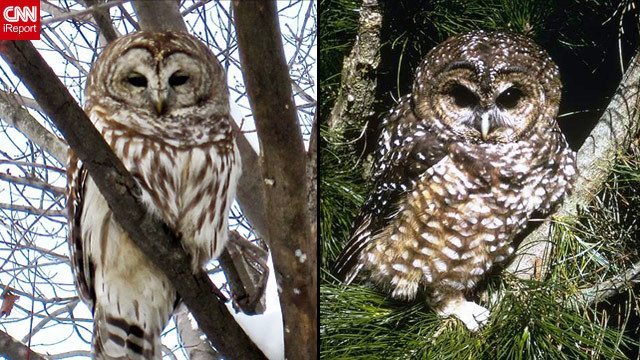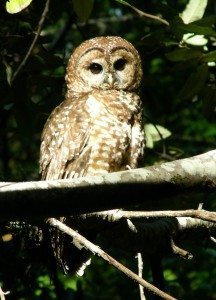Barred and Spotted Owls, cousins and rivals
By Jack Dumbacher
The Barred Owl (Strix varia) is the eastern cousin to our western Spotted Owl (Strix occidentalis). Like the Spotted Owl, the Barred Owl lives in forests, hunts at night, and feeds largely on small mammals. They differ in that the Barred Owl is more of a generalist opportunistic predator (feeding also on crayfish, snakes, even small birds and insects), has a broader habitat tolerance, and is slightly larger and more aggressive than the Spotted Owl.
In the last 100 years, Barred Owls have gradually extended their range westward, and around 1959, they began to formally “invade” the Spotted Owl’s range in British Columbia. By the 1970’s, Barred Owls were documented in Washington and Oregon, by 1976 they were documented in northern California, and the first Barred Owls were documented in Marin County in 2003.
On the one hand, this is now one more good bird that you can reliably “tick” on your Bay Area bird list. On the other hand, evidence is mounting that Barred Owls are having a significant detrimental effect on Spotted Owls – they compete for food and nesting sites, they are aggressive to Spotted Owls, they breed faster and disperse farther, they even interbreed with Spotted Owls and have an unknown effect on each others genomes.

In 2011, the Revised Recovery Plan for the Northern Spotted Owl identified competition with the invading Barred Owl as one of the most pressing threats to the Northern Spotted Owl. The easier it is to see a Barred Owl, the harder it is to see a Spotted Owl.
Again, on the one hand, this is a fascinating biological experiment. What will be the final outcome? Will the owls interbreed to become a new hybrid species? Will Barred Owls outcompete Spotted Owls in the western states? Or will they achieve an equilibrium and continue to co-exist side by side? No one knows the answer, but one goal of conservation biology is to create a natural environment where species can continue to evolve and do naturally what species will do.

On the other hand, it is not clear that this experiment is completely natural. There is some hint that human-caused habitat and climate change aided the Barred Owls in their westward dispersal. Human changes to western forests may have tipped the hand of evolution to favor Barred Owls in these now-disturbed forests. And another goal of conservation is to preserve “biodiversity” that is often measured in numbers of species present. We would hate to lose a species like the Spotted Owl to a common species that has become “weedy.” And federal law mandates that wildlife managers come up with a plan to preserve endangered species – and the Northern Spotted Owl is federally listed under the Endangered Species Act.
So biologists, wildlife managers, local conservation organizations, and others are putting their heads together to figure out what is to be done – and even what CAN be done at this point. The discussion is a fascinating one, and solutions range from doing nothing to launching an all-out campaign to eliminate Barred Owls from Spotted Owl habitat. And let me remind you that it is impossible not to pick sides – what humans have been doing for the last 100 years has already unwittingly made certain choices or favored certain outcomes. To “do nothing” is really to consciously endorse the unconscious decisions we have already made.
As this drama unfolds over the next couple of decades, I encourage you to get out and bird our forests at night. We are witnessing an epic battle between these species, with a totally uncertain outcome. The very existence of the Spotted Owl may be hanging in the balance.
Birding for Strix Owls
Northern Spotted Owls are found in mature coniferous forests in Washington, Oregon, and the coastal ranges of California south to Marin County. In the Bay Area, the best places to find both species are valleys and hillsides with redwood and douglas fir forest, especially around Muir Woods and the flanks of Mt. Tamalpais (Mill Valley, Baltimore Valley Open Space, etc.).
The best way to find both species is by listening for their calls. Spotted Owls have a characteristic 4-note call and Barred Owls tend to give an eight-note “who cooks for you, who cooks for you” call. Both are large “earless” owls that look superficially similar, especially in the poor light of dusk when you are most likely to see them, but the Barred Owls have vertical brown and light barring or streaking on the belly and lower chest, whereas the Spotted Owl has light spots. When owling, avoid playing calls of these two owls. The Northern Spotted Owl is protected, so it is prohibited to harass or disturb them. Spotted Owls tend to retreat and remain quiet after hearing the calls of the more aggressive Barred Owls.
Want to learn more about the conservation issues around Barred and Spotted Owls? The Oregon office of the U.S. Fish and Wildlife Service has a good page on Spotted Owls, with links to research papers and the agency’s June 2011 recovery plan for the Spotted Owl.
